
by Henry Thomas Alken
Illustration, 1822
Monkey-baiting is a blood sport involving the baiting of monkeys against dogs.

Monkey-baiting is a blood sport involving the baiting of monkeys against dogs.
The English were always keen for something new to challenge their dog fighting breeds. This resulted in unusual fights, sometimes with very surprising outcomes. 'Dog versus Monkey' was shown to be such a match-up.
These monkey gladiators proved to be a formidable opponent for the canine warrior; owners and handlers of fighting dogs frequently underestimated the monkey's abilities. The monkey's intelligence, dexterity, unorthodox fighting style and gameness proved to be overwhelming for many canine opponents. [1]

The following occurrence is from The Sporting Magazine in the year 1799:
This monkey-baiting inspired the famous English animal painter, Samuel Howitt, to illustrate this account in the engraving entitled The Battle of the Bulldog and the Monkey circa 1799, which preserved this fight for future generations.
Jacco Macacco was a fighting ape or monkey who was exhibited in monkey-baiting matches at the Westminster Pit in London in the early 1820s. He achieved some measure of fame among the sporting community through his reputed prodigious record of victories against dogs. He was described as ashy, with black fingers and muzzle and may have derived his first name from his association with the Jack Tars that brought him into the country.
Jacco was reported to weigh 4.5 to 5.5 kilograms (10 to 12 pounds) and was pitched against dogs of up to twice his weight for a bet from ten to fifty pounds that the dog would not last five minutes.

According to William Pitt Lennox :
His mode of attack, or rather of defence, was, at first, to present his back or neck to the dog, and to shift and tumble about until he could lay hold on the arm or chest, when he ascended to the windpipe, clawing and biting away, which usually occupied him about one minute and a half, and if his antagonist was not speedily with drawn, his death was certain; the monkey exhibited a frightful appearance, being deluged with blood - but it was that of his opponent alone; as the toughness and flexibility of his own skin rendered him impervious to the teeth of the dog. [2]
Lennox writes that after several fights, Jacco adapted his technique and would overcome his canine opponents by leaping directly on their backs and manoeuvring himself into a position where he could tear at their windpipes while remaining out of reach of their jaws.
The following is a fictionalized account by Pierce Egan from Life in London in which his heroes, Tom and Jerry, visit the Westminster Pit in the year 1820:


Jacco had finished off fourteen dogs in a row, but then he was challenged by a canine named Puss, who had a similar record. Puss suffered a lacerated neck and Jacco had his jaw torn off, both died shortly after the match. [3]

The Staffordshire Bull Terrier, also called the Staffy or Stafford, is a purebred dog of small to medium size in the terrier group that originated in the northern parts of Birmingham and in the Black Country of Staffordshire, for which it is named. They descended from 19th-century bull terriers that were developed by crossing bulldogs with various terriers to create a generic type of dog generally known as bull and terriers. Staffords share the same ancestry with the modern Bull Terrier, although the two breeds developed along independent lines, and do not resemble each other. Modern Staffords more closely resemble the old type of bull terrier, and were first recognised as a purebred dog breed by The Kennel Club of Great Britain in 1935.

Bull-baiting is a blood sport involving pitting a bull against dogs with the aim of attacking and subduing the bull by biting and holding onto its nose or neck, which often resulted in the death of the bull.
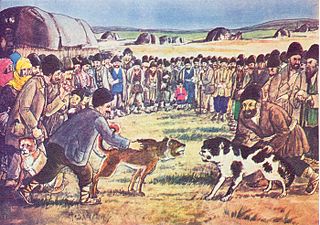
Dog fighting is a type of blood sport that turns game and fighting dogs against each other in a physical fight, often to the death, for the purposes of gambling or entertainment to the spectators. In rural areas, fights are often staged in barns or outdoor pits; in urban areas, fights are often staged in garages, basements, warehouses, alleyways, abandoned buildings, neighborhood playgrounds, or in the streets. Dog fights usually last until one dog is declared a winner, which occurs when one dog fails to scratch, dies, or jumps out of the pit. Sometimes dog fights end without declaring a winner; for instance, the dog's owner may call the fight.
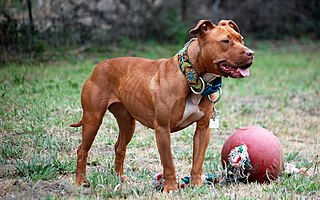
The American Pit Bull Terrier (APBT) is a dog breed recognized by the United Kennel Club (UKC) and the American Dog Breeders Association (ADBA), but not the American Kennel Club (AKC). It is a medium-sized, short-haired dog, of a solid build, whose early ancestors came from England. When compared with the English Staffordshire Bull Terrier, the American Pit Bull Terrier is larger by margins of 6–8 inches (15–20 cm) in height and 25–35 pounds (11–16 kg) in weight. The American Pit Bull Terrier varies in size: males are normally about 18–21 inches (45–53 cm) in height and around 35–60 pounds (15–27 kg) in weight, while females are normally around 17–20 inches (43–50 cm) in height and 30–50 pounds (13–22 kg) in weight.

The Olde English Bulldogge is an American dog breed, recognized by the United Kennel Club (UKC) in January 2014. The breed is listed in the UKC Guardian Dog Group. Five years prior to UKC recognition, the breed was registered by the former Canine Developmental, Health and Performance Registry (CDHPR), a privately held business located in Kalamazoo, Michigan. In the early 2000s, CDHPR had been working with the UKC under a unique agreement to develop breeding plans and strategies in an effort to produce improved breeds of dogs that would be accepted as purebred and, therefore, eligible for UKC registration.

The Alaunt is an extinct type of dog which came in different forms, with the original possibly having existed in North Caucasus, Central Asia and Europe from ancient times.

Weight pulling is a dog sport involving a dog pulling a cart or sled loaded with weight a short distance across dirt/gravel, grass, carpet, or snow. It is a modern adaptation of freighting, in which dogs were used as freight animals to move cargo.

The Old English Bulldog is an extinct breed of dog.

Rat-baiting is a blood sport that involves releasing captured rats in an enclosed space with spectators betting on how long a dog, usually a terrier, takes to kill the rats. Often, two dogs competed, with the winner receiving a cash prize. It is now illegal in most countries.

Lion-baiting is a blood sport involving the baiting of lions against dogs.

Bull and terrier was a common name for crossbreeds between bulldogs and terriers in the early 1800s. Other names included half-and-halfs and half-breds. It was a time in history when, for thousands of years, dogs were classified by use or function, unlike the modern pets of today that were bred to be conformation show dogs and family pets. Bull and terrier crosses were originally bred to function as fighting dogs for bull- and bear-baiting, and other popular blood sports during the Victorian era. The sport of bull baiting required a dog with attributes such as tenacity and courage, a wide frame with heavy bone, and a muscular, protruding jaw. By crossing bulldogs with various terriers from Ireland and Great Britain, breeders introduced "gameness and agility" into the hybrid mix.
Human-baiting is a blood sport involving the baiting of humans against dogs. There are at least three known documented cases of human-baiting, all of which occurred in England in the 19th century.
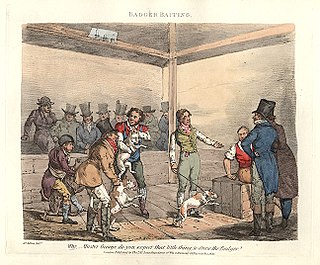
Badger-baiting is a form of blood sport in which badgers are baited with dogs. A baiting session typically results in the death of the badger, and possibly serious injuries to the dogs.
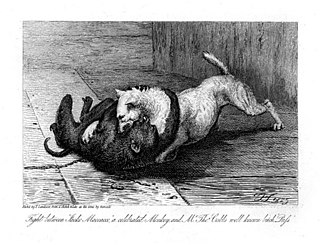
Jacco Macacco was a fighting ape or monkey who was exhibited in monkey-baiting matches at the Westminster Pit in London in the early 1820s. He achieved some measure of fame among the sporting community through his reputed prodigious record of victories against dogs, but was brought to wider attention by depiction in popular literature, artworks and by citation in speeches to Parliament by the animal welfare campaigner Richard Martin. Jacco's most famous fight, against the equally well-known bitch Puss, seems to have marked the end of his career: he may have died as a result of injuries received during the match or of an unrelated illness sometime afterwards. His ashes are claimed to be housed at the True Crime Museum in Hastings, East Sussex.
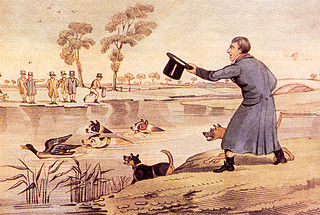
Duck-baiting is a blood sport involving the baiting of ducks against dogs.

Dog fighting in the United States is an activity in which fights between two game dogs are staged as a form of entertainment and gambling. Such activity has existed since the early 19th century in the United States and was gradually prohibited in all states. It continues as an underground activity in both rural and urban locations.
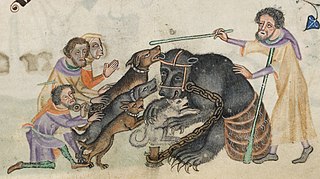
Bear-baiting is a blood sport in which a chained bear and one or more dogs are forced to fight one another. It may also involve pitting a bear against another animal. Until the 19th century, it was commonly performed in Great Britain, Sweden, India, Pakistan, and Mexico among others.
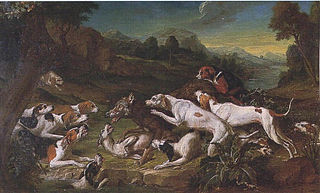
Wolf-baiting is a blood sport involving the baiting of wolves against dogs.
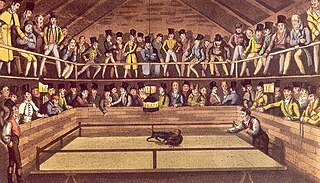
The Westminster Pit was a well-known blood sport arena in nineteenth-century London, England. It reached a zenith of popularity between 1820 and 1830, and hosted such spectacles as dog-fighting, cock-fighting, bear-baiting, badger-baiting, monkey-baiting, and rat-baiting. A legal enterprise at the time, the Westminster Pit openly declared its activities, ushering notoriety on the district in which it existed.
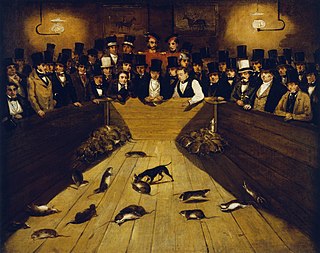
Tiny the Wonder was an English Toy Terrier famous in the City of London in the mid-19th century for being able to kill 200 rats in an hour in the city's rat-baiting pits. At the time, the world record for killing 100 rats was 5 minutes, 30 seconds, held by a bull and terrier named Billy.